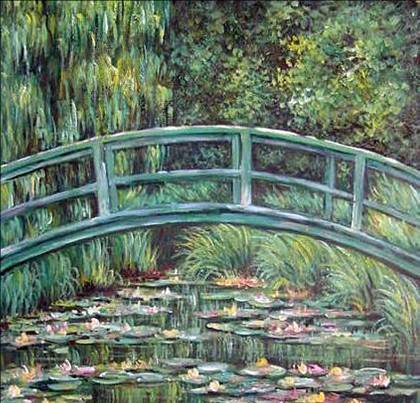As a manifestation of my interest in connection-making, observe as I make connections among my last three posts. In my most recent musing, I wrote about the wonderful potential for iPod shuffling to create interesting and unexpected connections and suggested that perception of art has a lot to do with making our own connections with what we see/hear/read/etc. Before that, I "translated" Stravinsky and myself into Simpsons form, and even transformed the Simpsons theme into Stravinsky, Bach, and Mozart. "Simp"ly put, the process of translation is my favorite pet topic in the world of aesthetics, whether the subject is translating a poem from French to English, transcribing a concerto accompaniment from orchestra to piano, or transimpsing a real-world image into Simpsons yellow. What I find most interesting is the question of how identity is maintained for a given subject when it passes from one medium to another, even as the medium (new language) demands that something be lost. Obviously, connections are key.
For example, if Stravinsky were to appear in a Simpsons episode, it would be odd to create photorealistic animations of the real Stravinsky like so:
The following makes much more sense:
Stravinsky becomes more real "in the Simpsons world" by becoming less like what he really looks like. In this thought experiment, The Simpsons functions as a sort of visual language into which images of people and objects may be translated. For me or Stravinsky to keep our identity in the new world, we have to be transformed; yet, there is something maintained (with more or less success) that enables us to see the connection between the real thing and the Simpsons thing. Translation necessarily involves changes, yet it also depends on certain recognizable identity features being maintained (e.g. Stravinsky's nose, my goatee, the melody, rhythms, and harmonies of a concerto, etc.) Thus, translation can help reveal what we perceive as more or less essential to identity recognition.
One of my favorite examples of this comes from one of my all-time favorite Simpsons episodes: "The Crepes of Wrath." When Bart first arrives in France as an exchange student, his host drives him through the countryside and we see, in quick succession, the following background scenes:
Obviously, these make reference to the following famous paintings by Monet, Van Gogh, Manet, and Rousseau, but their distinctive styles have been translated into the visual language of the Simpsons so that, in the context of the show, they are more real representations of these artists than if the animators had just put photorealistic reproductions of the paintings in the background:
  |   |
The process is not much different than having a German-speaking audience hear Shakespeare in German; that makes for an experience that is simultaneously less true to the real Shakespeare (because the English is lost) and more true (because the audience understands much more of the underlying content). The use of the French paintings is also a good example of how art can function as a cultural sign; even for the viewer who may not recognize what's going on in those brief seconds, the reference to iconic paintings, which ironically are not particularly realistic to begin with, makes a stronger "this is France" statement than more realistic French countryside imagery might. Isn't art something? And how 'bout those Simpsons creators, tucking art history so subtly into the narrative? Maybe Barbara Bush would have thought more highly of them if she knew that.






No comments:
Post a Comment